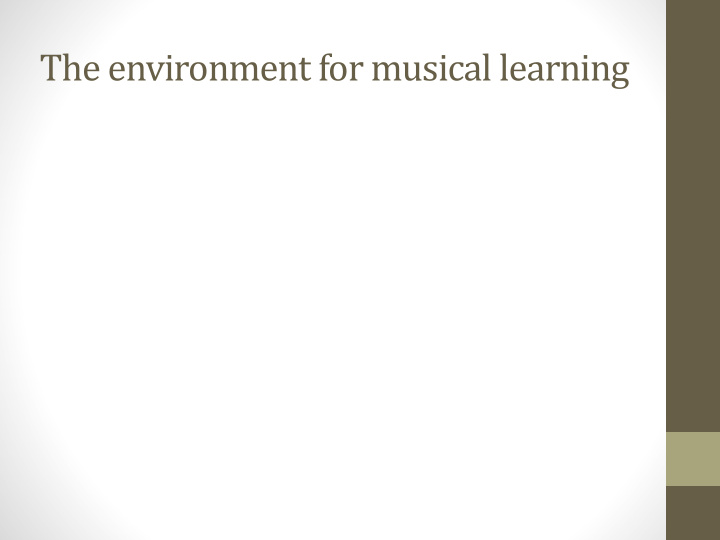



The ¡environment ¡for ¡musical ¡learning
A ¡creative, ¡confident ¡learner
Environment ¡for ¡musical ¡learning 2.2 ¡Be ¡able ¡to ¡prepare ¡the ¡environment ¡for ¡musical ¡learning ¡ activities ¡with ¡children ¡and ¡young ¡people ¡ 2.2.1 ¡Prepare ¡learning ¡environments ¡that: ¡ • meet ¡the ¡technical ¡and ¡creative ¡requirements ¡of ¡the ¡planned ¡ musical ¡learning ¡activities ¡ • are ¡appropriate ¡for ¡the ¡age ¡range ¡of ¡the ¡children ¡and ¡young ¡ people ¡involved ¡ • meet ¡any ¡particular ¡needs/interests ¡of ¡children ¡and ¡young ¡ people ¡ • minimise ¡barriers ¡to ¡learning
Task What ¡are ¡the ¡factors ¡that ¡make ¡ up ¡a ¡musical ¡learning ¡ environment?
Learning ¡environment Which ¡is ¡the ¡most ¡musical ¡learning ¡ environment? ¡Why? ¡ Who ¡do ¡you ¡think ¡is ¡learning ¡the ¡most ¡ musically? ¡ Which ¡looks ¡like ¡the ¡most ¡valuable ¡ musical ¡learning ¡experience ¡and ¡why?
Environment ¡for ¡learning What ¡are ¡your ¡values ¡and ¡beliefs ¡in ¡creating ¡an ¡ environment ¡for ¡musical ¡learning? ¡ ¡ How ¡can ¡you/do ¡you ¡make ¡them ¡happen? ¡ How ¡are ¡your ¡expectations ¡of ¡behaviour ¡and ¡ musical ¡learning ¡negotiated, ¡described? ¡ How ¡is ¡good ¡behaviour ¡developed ¡and ¡ encouraged?
Barriers ¡to ¡learning
Possible ¡barriers • Social ¡difficulties ¡ • Fear ¡of ¡failure ¡ • Fear ¡of ¡criticism ¡ • Peer ¡pressure ¡ • Fear ¡of ¡rejection ¡ • Lack ¡of ¡confidence ¡ • Motivation ¡– ¡lack ¡of ¡direction, ¡goal, ¡understanding ¡the ¡big ¡picture ¡ • Health ¡and ¡disability ¡ • Tired ¡ • Lack ¡of ¡self ¡esteem ¡ • Learning ¡disability ¡ • Language ¡ • Hungry ¡ • Gifted ¡and ¡talented ¡ ¡ • Already ¡has ¡grade ¡5 ¡on ¡flute, ¡not ¡interested ¡in ¡learning ¡the ¡trumpet
Individual ¡needs What ¡might ¡the ¡needs ¡of ¡individual ¡ pupils ¡be? ¡E.g. ¡Jason ¡ How ¡might ¡you ¡plan ¡to ¡address ¡ them?
Maslow’s ¡Hierarchy ¡of ¡Need
Hierarchy ¡of ¡needs Match ¡the ¡needs ¡on ¡the ¡cards ¡to ¡the ¡ appropriate ¡place ¡on ¡the ¡triangle ¡ Look ¡at ¡case ¡study ¡child ¡‘Jason’ ¡what ¡might ¡ be ¡his ¡unmet ¡needs? ¡ How ¡might ¡we ¡help ¡meet ¡his ¡needs ¡in ¡a ¡ music ¡session?
Challenging ¡situations/behaviours Consider ¡the ¡pre ¡course ¡task ¡ ¡3) ¡Think ¡of ¡a ¡pupil ¡that ¡you ¡teach ¡whose ¡ behaviour ¡you ¡find ¡challenging ¡and/or ¡who ¡ is ¡not ¡making ¡the ¡progress ¡that ¡you ¡would ¡ expect. ¡Make ¡some ¡brief ¡notes ¡about ¡this ¡ pupil ¡and ¡what ¡you ¡might ¡consider ¡to ¡be ¡ actions ¡that ¡you ¡could ¡try ¡to ¡improve ¡their ¡ learning ¡
Challenging ¡situations/behaviours In ¡groups ¡of ¡3 ¡one ¡person ¡describe ¡the ¡pupil ¡about ¡ whom ¡they ¡have ¡brought ¡information ¡(anonymise ¡ it) ¡The ¡others ¡should ¡use ¡questioning ¡to ¡help ¡ them ¡think ¡through ¡ ¡ • The ¡barriers ¡to ¡learning ¡the ¡pupil ¡might ¡need ¡to ¡ overcome, ¡the ¡learning ¡environment ¡ • How ¡might ¡they ¡help ¡the ¡pupil ¡to ¡develop ¡social, ¡ emotional, ¡behavioural ¡as ¡well ¡as ¡musical ¡skills ¡ • Teaching ¡and ¡learning ¡strategies ¡that ¡might ¡be ¡ helpful ¡ ¡ ¡ ¡ ¡ ¡ ¡ ¡ ¡ ¡ ¡ ¡ ¡ ¡ ¡ ¡ ¡ ¡ ¡ ¡ ¡ ¡ ¡ ¡ ¡ ¡ ¡ ¡ ¡ ¡ ¡ ¡ ¡ ¡ ¡ ¡ ¡ ¡(then ¡swap ¡roles)
Positive ¡learning ¡environments How ¡can ¡we ¡avoid ¡phrasing ¡things ¡in ¡a ¡ negative ¡way? ¡ • You ¡always …… .. ¡ • You ¡never ……… . ¡ • People ¡like ¡you ……… . ¡ • Stop ¡acting ¡like ¡a ¡two ¡year ¡old ……… . ¡ How ¡would ¡it ¡feel ¡to ¡receive ¡such ¡ statements? ¡ What ¡might ¡the ¡impact ¡be?
How ¡do ¡we ¡know ¡if ¡pupils ¡are ¡comfortable, ¡interested ¡and ¡engaged?
How ¡do ¡we ¡know ¡if ¡pupils ¡are ¡comfortable, ¡interested ¡and ¡engaged? • Pupils ¡willing ¡to ¡ask ¡questions ¡ • Take ¡risks ¡ • Experiment ¡ • They ¡are ¡well ¡motivated, ¡absorbed, ¡excited, ¡confident ¡ • They ¡ask ¡good ¡questions ¡ • They ¡take ¡pride ¡in ¡the ¡performance ¡ • They ¡listen ¡to ¡one ¡another ¡sensitively/positively ¡ • They ¡are ¡on ¡task ¡ • They ¡support ¡one ¡another ¡ • They ¡are ¡confident ¡to ¡perform ¡to ¡one ¡another ¡ • They ¡are ¡looking ¡forward ¡to ¡the ¡next ¡lesson?
Risks ¡and ¡Hazards 2.2.2 ¡Identify ¡potential ¡risks ¡or ¡hazards ¡that ¡ could ¡affect ¡the ¡health ¡and ¡safety ¡of ¡ children ¡and ¡young ¡people ¡in ¡the ¡learning ¡ environment ¡ ¡ ¡ 2.1.3 ¡Take ¡actions ¡to ¡minimise ¡risks ¡and ¡ remove ¡hazards
Potential ¡risk ¡and ¡hazards • Medical ¡issues ¡ • Acoustic ¡levels ¡– ¡ear ¡plugs ¡noise ¡ • Disability ¡access ¡ • Windows ¡in ¡doors ¡ • Safeguarding ¡ • Size ¡and ¡quality ¡of ¡instruments ¡ • Data ¡ ¡ • Sharing ¡mouthpieces ¡ • Cluttered ¡doorways ¡ • Electrical ¡cables ¡ • Blocked ¡fire ¡exits ¡ • Lifting/carrying ¡equipment/ instruments ¡ • Bags/ ¡instrument ¡cases ¡in ¡the ¡ way ¡ • Storage ¡ • Cups ¡of ¡coffee/hot ¡liquids ¡ • Challenging ¡behaviour ¡– ¡what ¡ if? Whose ¡responsibility? ¡ Know ¡the ¡policies/procedures ¡
Recommend
More recommend